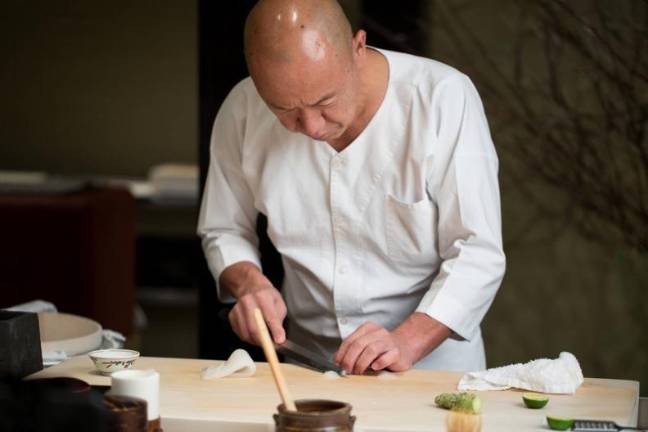Sushi, a Centuries Old Japanese Food, Has Emerged as Popular and Healthful Dish in Present Day NYC
Sushi, which is growing in popularity, offers a healthful, low-calorie, nutrient-rich dish that delivers the omega-3 fatty acids believed to lower blood pressure and reduce the risk of cardiovascular diseases.

Thirteen centuries ago, perhaps on a hot summer day when the thermometer hit as high as it may this week, some savvy Japanese cook decided that was too hot to light the fire required to cook dinner. Instead, he (or she) wrapped bits of fish in seaweed, rolled that in rice and 出来上がり /Voila! A new taste treat was born.
Fast forward nine centuries to when that summer something now called sushi–which means “sour rice” –made its way into kitchens all over the Pacific islands. Then zip through another 300 years to the start of the 20th century, when Japanese immigration to the United States increased, and main stream Sushi restaurants began to pop up in Los Angeles and New York, initially catering to a niche market of Japanese food enthusiasts dining on three distinct types of sushi: nigiri, maki, and sashimi.
The first is the simplest: a small piece of seafood on top of a ball of rice. The second is the original and still most familiar version, those bits of fish wrapped in seaweed and rolled in rice. The third is thinly sliced raw fish or seafood served with soy sauce and the searingly-hot wasabi which surprisingly is made from a plant in the usually mild broccoli and cabbage family.
Californians added two more to the menu: Rolls with avocado, cucumber, and crab meat and “dragon rolls” known as Uramaki (“inside out”) that look something like miniature Subway sandwiches.
Today this summer delight in vinegared rice (the sour part) may not be as American as apple pie, but it’s a treat that serves up important nutrients. Any version you choose is more than a delicious dish. It’s also a healthful low-calorie nutrient-rich option that delivers the omega-3 fatty acids believed to lower blood pressure and reduce the risk of cardiovascular diseases. And it’s packed with protein. According to the website WebMD, a single California roll delivers 15 grams of the muscle-building nutrient, just about one third the Recommended Dietary Allowance (RDA) for a healthy adult.
Finally, while there are no studies to prove the claim, some nutrition folks think that the vinegar in sushi rice is a natural probiotic that promotes the growth of good bacteria in the gut, thus improving digestion.
There is, of course, a caution. The USDA warns that foods made with raw fish are more likely to contain parasites or bacteria than foods made from cooked fish. In other words, choose a reliable restaurant or deli such as those on Yelp’s list of the ten best in Manhattan. And to eliminate all worries, you might want to check the label for the word cooked. For a real eating experience, try a restaurant run by a famous sushi chef such as Nobu Matsuhisa, known for his inventive dishes that combine traditional Japanese techniques with flavors from around the world. His multiple establishments around the globe include two in Manhattan: Downtown at the historic 195 Broadway and up town at the Plaza Athenee at 40 east 57 street
Finally, Michelin mavens know that Masa at 10 Columbus Circle has three stars, one of only six three-starred restaurants in all of New York City. More than that, it’s the only three-starred sushi restaurant in the entire country. Masa’s operating hours for indoor dining are Tuesday-Saturday, lunch 12 p.m.–12:30 p.m. and diner 5 p.m.–8 p.m. It is closed on Thursday for lunch and not open for service Sunday and Monday. It is currently accepting reservations only by email or through Tock.